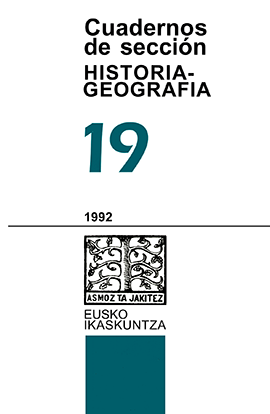Euskal historiografiaren barrena : gizarte arazoen kezka eta azterketa XX mendeko tokiko historiografian

Agirreazkuenaga Zigorraga, Joseba
- Publication year:
- 1992
- Publication place:
- Donostia-San Sebastián
- ISSN:
- 0212-6397
Summary
Analysis of the society in basque historiography in a local context I. Gurrutxaga wrote in 1933 "a phenomenon of idealization of our past, with a very ancient origin, specific to a very traditional country" but penal files withessed the "tension of classes" in the XVIII century. However, local historiography of the first half of the XX century hardly thought of subjects in relation to conflicts and social life of the community. We can observe three stages in the evolution of local historiography: 1.- The stage of dictionaries, with a great development in the XIX century, which heritage was collected by the magnificent work of the General Basque-Navarre Geography. 2.- The stage of local monographs. During the XIX century, some important ones were written, but in the first two decades of this century a promotion policy of local historical monographs will be developed. The authors were usually file clerks, who had a positivist vision and a data cult, which did not go beyond the good chronological description, probably as a reaction to romanticism from the end of the XIX century, where they grew. Carmelo Echegaray, Serapio Mugica, Teófilo Guiard, Gregorio Mugica were the authors who succeded in transmitting their personality to their local monographs. 3.- From 1920-30, we can observe another generation of historians, whose publications have a more ambitious approach, with subjects related to society and the social conflict, as the centre of interest of researchers. The figure of Bonifacio Etxegaray represents the transition period between both generations. He started his hitoriographic production in 1909, but works as "La Vecindad, Relaciones que engendra en el País Vasco" (The neighbourhood, relationships generated in the Basque Country) (1932), are a good example of the new historiographic trend. The work analyzes the basis of social nature of traditional community, both in town and country. Works by I. Gurrutxaga, Th. Lefebvre, Ciriquiain Gaiztarro and Julio Caro Baroja, provide excellent analysis of social life and conflicts at a local level, although therories underlying in their researches are not always coincident. In 1964, an ambitious plan was presented in order to produce local stories. The group Dr. Camino of San Sebastian History was founded and in the subsequent years a large number of monographs about villages in Guipúzcoa were published being the documentary empiricism the prevailing characteristic of monographsSing up and download the publications of Eusko Ikaskuntza
Are you a registered member?. Access




